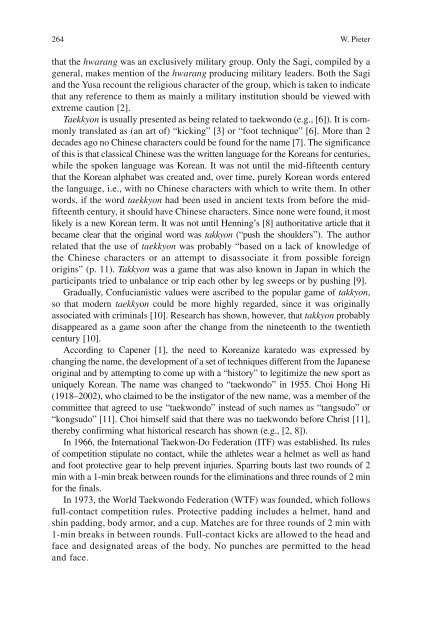Nutrition in Combat Sports
Nutrition in Combat Sports
Nutrition in Combat Sports
Create successful ePaper yourself
Turn your PDF publications into a flip-book with our unique Google optimized e-Paper software.
264 W. Pieter<br />
that the hwarang was an exclusively military group. Only the Sagi, compiled by a<br />
general, makes mention of the hwarang produc<strong>in</strong>g military leaders. Both the Sagi<br />
and the Yusa recount the religious character of the group, which is taken to <strong>in</strong>dicate<br />
that any reference to them as ma<strong>in</strong>ly a military <strong>in</strong>stitution should be viewed with<br />
extreme caution [2] .<br />
Taekkyon is usually presented as be<strong>in</strong>g related to taekwondo (e.g., [6] ). It is commonly<br />
translated as (an art of) “kick<strong>in</strong>g” [3] or “foot technique” [6] . More than 2<br />
decades ago no Ch<strong>in</strong>ese characters could be found for the name [7] . The significance<br />
of this is that classical Ch<strong>in</strong>ese was the written language for the Koreans for centuries,<br />
while the spoken language was Korean. It was not until the mid-fifteenth century<br />
that the Korean alphabet was created and, over time, purely Korean words entered<br />
the language, i.e., with no Ch<strong>in</strong>ese characters with which to write them. In other<br />
words, if the word taekkyon had been used <strong>in</strong> ancient texts from before the midfifteenth<br />
century, it should have Ch<strong>in</strong>ese characters. S<strong>in</strong>ce none were found, it most<br />
likely is a new Korean term. It was not until Henn<strong>in</strong>g’s [8] authoritative article that it<br />
became clear that the orig<strong>in</strong>al word was takkyon (“push the shoulders”). The author<br />
related that the use of taekkyon was probably “based on a lack of knowledge of<br />
the Ch<strong>in</strong>ese characters or an attempt to disassociate it from possible foreign<br />
orig<strong>in</strong>s” (p. 11). Takkyon was a game that was also known <strong>in</strong> Japan <strong>in</strong> which the<br />
participants tried to unbalance or trip each other by leg sweeps or by push<strong>in</strong>g [9] .<br />
Gradually, Confucianistic values were ascribed to the popular game of takkyon ,<br />
so that modern taekky o n could be more highly regarded, s<strong>in</strong>ce it was orig<strong>in</strong>ally<br />
associated with crim<strong>in</strong>als [10] . Research has shown, however, that takkyon probably<br />
disappeared as a game soon after the change from the n<strong>in</strong>eteenth to the twentieth<br />
century [10] .<br />
Accord<strong>in</strong>g to Capener [1] , the need to Koreanize karatedo was expressed by<br />
chang<strong>in</strong>g the name, the development of a set of techniques different from the Japanese<br />
orig<strong>in</strong>al and by attempt<strong>in</strong>g to come up with a “history” to legitimize the new sport as<br />
uniquely Korean. The name was changed to “taekwondo” <strong>in</strong> 1955. Choi Hong Hi<br />
(1918–2002), who claimed to be the <strong>in</strong>stigator of the new name, was a member of the<br />
committee that agreed to use “taekwondo” <strong>in</strong>stead of such names as “tangsudo” or<br />
“kongsudo” [11] . Choi himself said that there was no taekwondo before Christ [11] ,<br />
thereby confirm<strong>in</strong>g what historical research has shown (e.g., [2, 8] ).<br />
In 1966, the International Taekwon-Do Federation (ITF) was established. Its rules<br />
of competition stipulate no contact, while the athletes wear a helmet as well as hand<br />
and foot protective gear to help prevent <strong>in</strong>juries. Sparr<strong>in</strong>g bouts last two rounds of 2<br />
m<strong>in</strong> with a 1-m<strong>in</strong> break between rounds for the elim<strong>in</strong>ations and three rounds of 2 m<strong>in</strong><br />
for the f<strong>in</strong>als.<br />
In 1973, the World Taekwondo Federation (WTF) was founded, which follows<br />
full-contact competition rules. Protective padd<strong>in</strong>g <strong>in</strong>cludes a helmet, hand and<br />
sh<strong>in</strong> padd<strong>in</strong>g, body armor, and a cup. Matches are for three rounds of 2 m<strong>in</strong> with<br />
1-m<strong>in</strong> breaks <strong>in</strong> between rounds. Full-contact kicks are allowed to the head and<br />
face and designated areas of the body. No punches are permitted to the head<br />
and face.

















